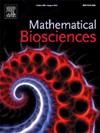Modelling the impact of organic molecules and phosphate ions on biosilica pattern formation in diatoms
IF 1.8
4区 数学
Q2 BIOLOGY
引用次数: 0
Abstract
The rapid and complex patterning of biosilica in diatom frustules is of great interest in nanotechnology, although it remains incompletely understood. Specific organic molecules, including long-chain polyamines, silaffins and silacidins, are essential in this process. The molecular structure of synthesized polyamines significantly affects the quantity, size and shape of silica precipitates. Experimental findings show that silica precipitation occurs at specific phosphate ion concentrations. We focus on the hypothesis that pattern formation in diatom valve structures is driven by the phase separation of species-specific organic molecules. The resulting organic structures serve as templates for silica precipitation. We investigate the role of phosphate ions in the self-assembly of these organic molecules and analyse how the reaction between them affects the morphology of the organic template. Using mathematical and computational techniques, we gain an understanding of the range of patterns that can arise in a phase-separating system. By varying the rate of dissociation and the initial concentrations of the reacting components we demonstrate that the resulting geometric features are highly dependent on these factors. This approach provides insights into the parameters controlling patterning. Additionally, we consider the effects of prepatterns, mimicking silica ribs that preexist the pores, on the final patterns.
模拟有机分子和磷酸盐离子对硅藻中生物二氧化硅图案形成的影响。
硅藻体中生物二氧化硅的快速和复杂的模式在纳米技术中引起了极大的兴趣,尽管它仍然没有完全被理解。特定的有机分子,包括长链多胺、硅烷和硅酸苷在这一过程中是必不可少的。合成的多胺的分子结构显著影响二氧化硅沉淀的数量、大小和形状。实验结果表明,在特定的磷酸盐离子浓度下,二氧化硅会发生沉淀。我们关注硅藻瓣结构的模式形成是由物种特异性有机分子的相分离驱动的假设。所得的有机结构可作为二氧化硅沉淀的模板。我们研究了磷酸盐离子在有机分子自组装中的作用,并分析了它们之间的反应如何影响有机模板的形态。利用数学和计算技术,我们了解了相分离系统中可能出现的模式范围。通过改变解离速率和反应组分的初始浓度,我们证明了所得到的几何特征高度依赖于这些因素。这种方法提供了对参数控制模式的深入了解。此外,我们考虑了预模式的影响,模拟存在于孔隙中的硅肋,对最终模式的影响。
本文章由计算机程序翻译,如有差异,请以英文原文为准。
求助全文
约1分钟内获得全文
求助全文
来源期刊

Mathematical Biosciences
生物-生物学
CiteScore
7.50
自引率
2.30%
发文量
67
审稿时长
18 days
期刊介绍:
Mathematical Biosciences publishes work providing new concepts or new understanding of biological systems using mathematical models, or methodological articles likely to find application to multiple biological systems. Papers are expected to present a major research finding of broad significance for the biological sciences, or mathematical biology. Mathematical Biosciences welcomes original research articles, letters, reviews and perspectives.
 求助内容:
求助内容: 应助结果提醒方式:
应助结果提醒方式:


